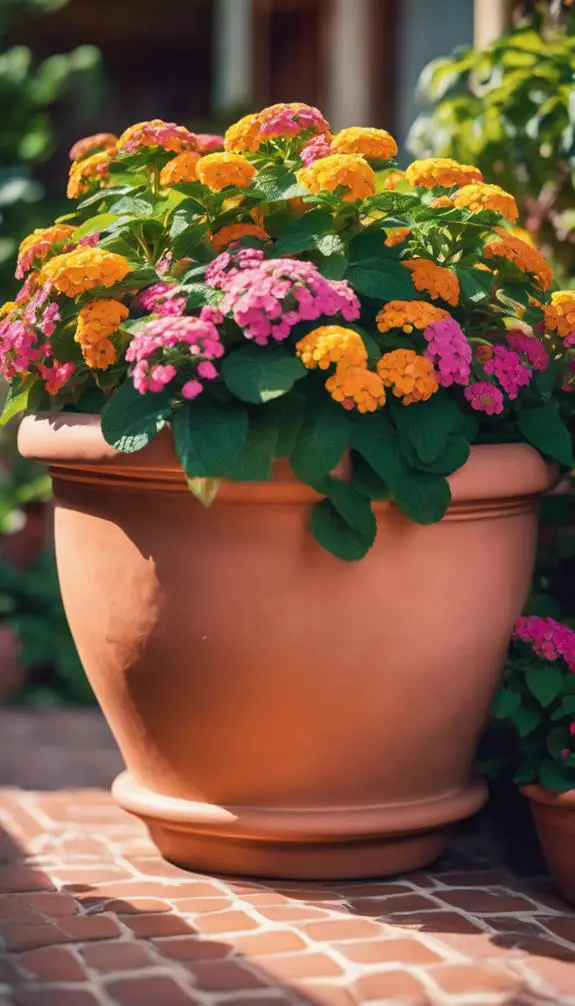As you prepare to grow lantana flowers in pots, you're likely wondering where to start. First, you'll need to choose a variety that thrives in your climate and has the growth habit you desire. Next, select a container that's large enough to accommodate the mature size of your plant, with breathable materials and drainage holes to prevent waterlogging. But that's just the beginning – you'll also need to get the soil mix just right, plant the seeds or seedlings at the correct depth, and provide the right amount of water and sunlight. Get these basics down, and you'll be well on your way to enjoying these vibrant blooms all season long.
Summary
- Choose a lantana variety that fits your pot size and desired growth habit, considering factors like hardiness zone and color options.
- Select a breathable container with drainage holes and fill it with a well-draining potting mix specifically designed for lantana.
- Plant lantana seeds or seedlings in the pot, leaving about an inch at the top for watering, and water when the top inch of soil feels dry.
- Provide at least six hours of direct sunlight per day, fertilize every 4-6 weeks, and prune regularly to maintain shape and encourage blooming.
- Deadhead spent flowers to promote frequent blooming and inspect plants regularly for pests and diseases, taking prompt action if issues arise.
Choosing the Right Lantana Variety
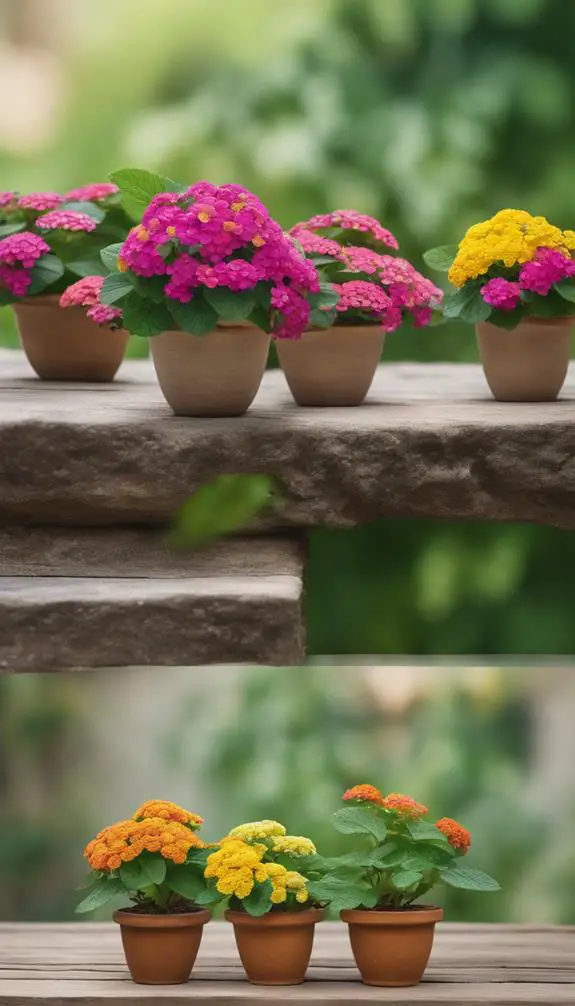
When selecting a lantana variety, consider factors such as growth habits, flower colors, and hardiness zones to guarantee you're getting the right fit for your garden.
You'll find lantana types range from compact and shrub-like to spreading and trailing. Some varieties grow up to 6 feet tall, while others remain compact at 1-2 feet.
Color options are vast, with blooms ranging from soft pastels to vibrant oranges, yellows, and pinks. You may also find bi-colored or tri-colored varieties for added visual interest.
Selecting a Container With Drainage
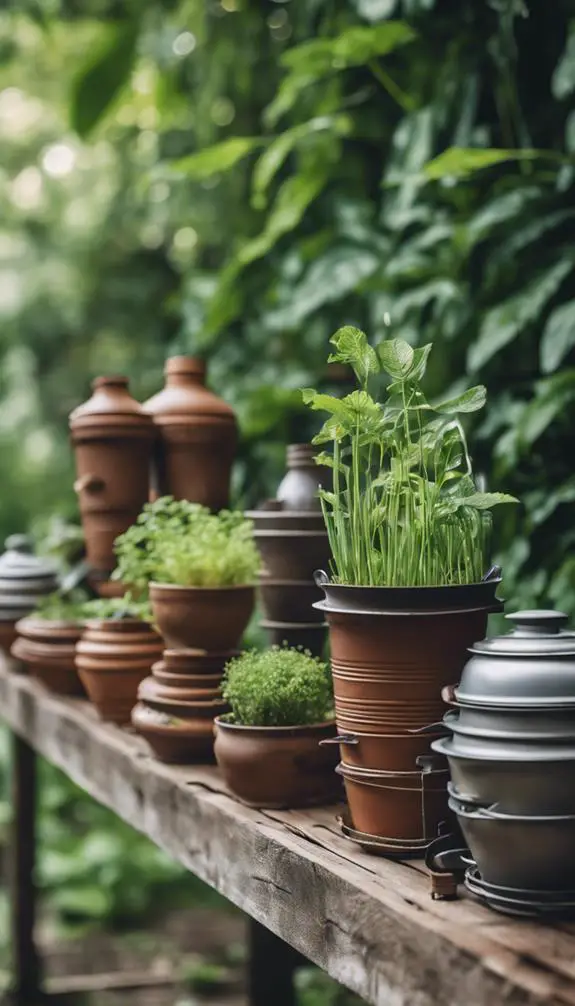
Six essential factors come into play when selecting a container with proper drainage for your lantana flowers.
You'll want to ponder the container size, ensuring it's large enough to accommodate the mature size of your lantana plant.
Material options are also vital, as they affect drainage and durability. Look for containers made from breathable materials like terracotta, ceramic, or wood, which allow for airflow and moisture release.
Avoid plastic or metal containers that can retain water and cause root rot. Additionally, ponder the weight and mobility of the container, as well as its aesthetic appeal.
Finally, make sure the container has drainage holes in the bottom to prevent waterlogged soil.
Soil Requirements for Lantana

Because lantana flowers thrive in well-draining soil, you'll want to select a potting mix that's specifically designed to prevent waterlogged soil conditions.
A well-draining medium is essential, as lantana's roots are prone to rot in soggy soil. Look for a mix that contains ingredients like perlite, vermiculite, or sand, which improve drainage and aeration.
An acidic mix with a pH between 6.0 and 6.5 is ideal, as lantana prefers slightly acidic to neutral soil. Avoid using regular garden soil, as it can compact and prevent proper drainage in pots.
How to Plant Lantana in Pots
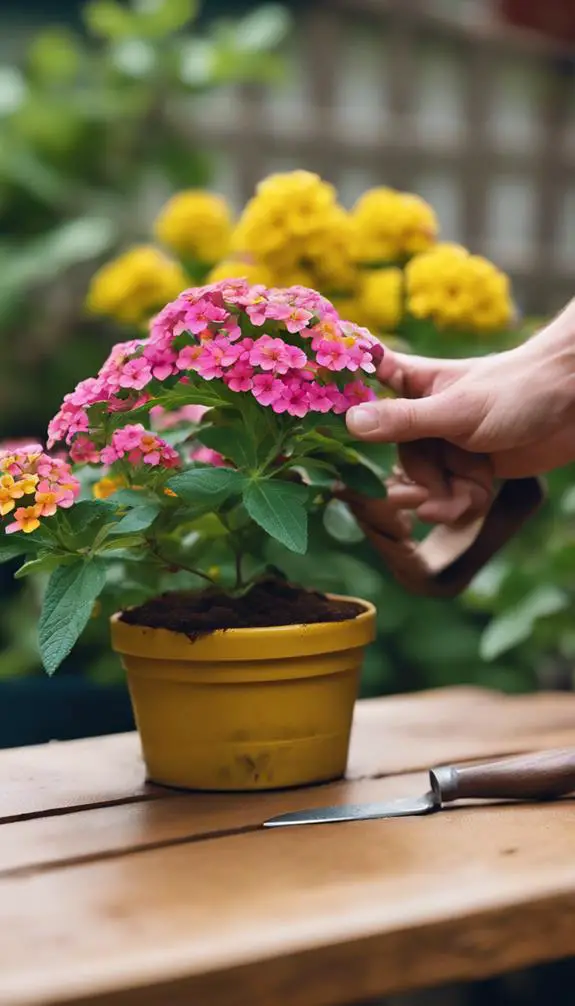
Now that you've selected the ideal potting mix for your lantana flowers, it's time to plant them in pots.
Begin by preparing your pot: wash it with soap and water, then dry it thoroughly to prevent any bacterial growth.
Fill the pot with the potting mix, leaving about an inch at the top for watering.
Check the soil temperature, aiming for 65-75°F (18-24°C) for perfect germination.
Plant the lantana seeds or seedlings about 1-2 inches deep, depending on their size.
Space them evenly, allowing for proper air circulation and growth.
Gently firm the soil around the plants to secure them in place.
Watering and Humidity Needs

When it comes to watering your lantana flowers, frequency matters: you'll want to water them when the top inch of soil feels dry to the touch, usually every 7-10 days in well-draining pots.
Be cautious not to overwater, as this can lead to root rot and other issues.
Additionally, maintaining a humid environment, ideally between 50-60% relative humidity, will help your lantana thrive.
Watering Frequency Matters
In lantana's native tropical habitats, consistent moisture fuels its vigorous growth, and replicating these conditions in your garden requires careful attention to watering frequency.
You'll want to water your potted lantana when the top 1-2 inches of soil feel dry to the touch. Overwatering can lead to water stress, causing roots to rot and stems to weaken.
Conversely, underwatering can cause water stress, too, as the plant struggles to survive. Aim for soil saturation, where the pot drains well and the soil is moist but not waterlogged.
Check the soil daily, and adjust your watering schedule accordingly. By finding this balance, you'll create an ideal environment for your lantana to thrive.
Humidity Level Importance
Your lantana plants thrive in humid environments, typically between 50% to 70% relative humidity.
To replicate this humid microclimate, you can place the pot on a tray filled with water and pebbles or use a humidifier nearby. This will create a tropical atmosphere, ideal for your lantana flowers to flourish.
As you monitor the humidity level, verify it doesn't drop below 40%, as this can lead to leaf drop and stunted growth. Conversely, excessive humidity above 80% can encourage fungal diseases.
Providing Adequate Sunlight
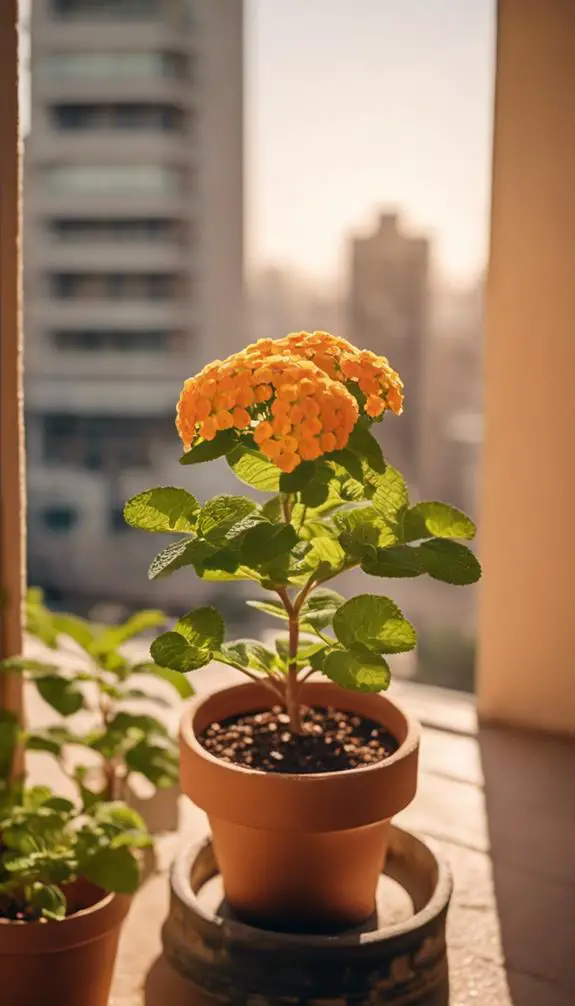
Most lantana varieties require at least six hours of direct sunlight per day to thrive, and some can even tolerate full sun, which means eight hours or more of direct sunlight.
When growing lantana in pots, you'll want to place them in a location that receives morning sun, which is gentler and less intense.
This will help your lantana flowers bloom profusely. However, if you live in a region with extremely hot summers, consider providing afternoon shade to prevent scorching.
A south-facing balcony or patio is ideal, as it receives direct sunlight for most of the day.
Just be sure to monitor the temperature and adjust the pot's position accordingly to guarantee your lantana receives the right amount of sunlight.
Fertilizing Lantana Flowers
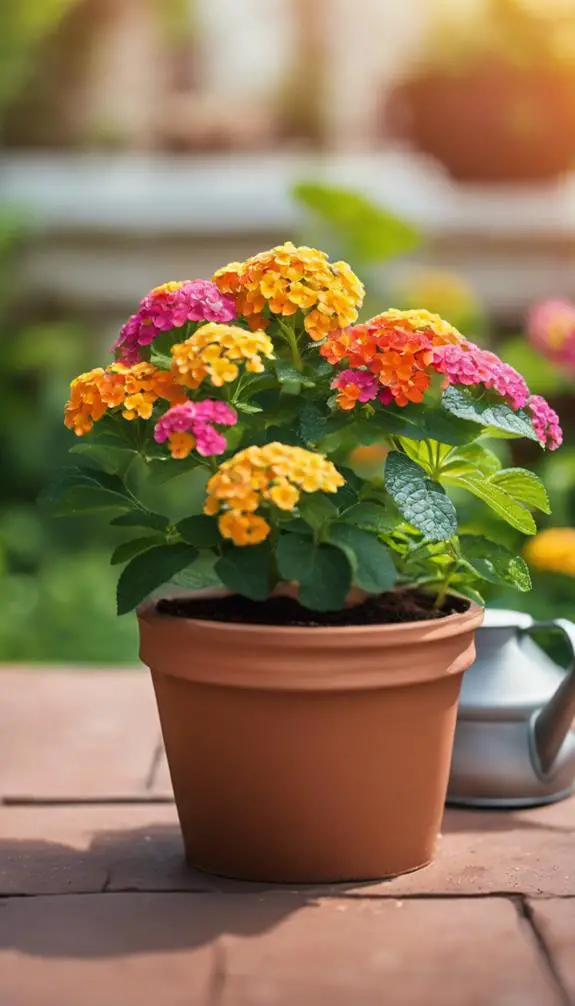
Lantana flowers' profuse blooming isn't just dependent on sunlight; they also require regular feeding to maintain their vigor.
You'll want to fertilize your potted lantana every 4-6 weeks during the growing season. Start by conducting soil tests to determine your potting mix's pH and nutrient levels.
Based on the results, you can adjust your fertilizer application accordingly. Opt for organic amendments like compost, manure, or fish emulsion to promote healthy microbial activity in the soil.
These amendments will release nutrients slowly, providing a steady supply for your lantana. Avoid over-fertilizing, as this can lead to weak growth and fewer blooms.
With regular feeding, your potted lantana will thrive and produce an abundance of vibrant flowers.
Pruning for Shape and Size

Pruning shears are your best friend when it comes to maintaining the shape and size of your potted lantana.
To keep your plant bushy and full, use pinching tips to remove the terminal bud, encouraging side shoots to grow. This technique will help you achieve a more compact shape.
For shaping techniques, prune your lantana regularly to maintain its desired size. Cut back long stems to about one-third of their length, making clean cuts just above a leaf node. This will promote new growth and prevent legginess.
Deadheading Lantana Blooms
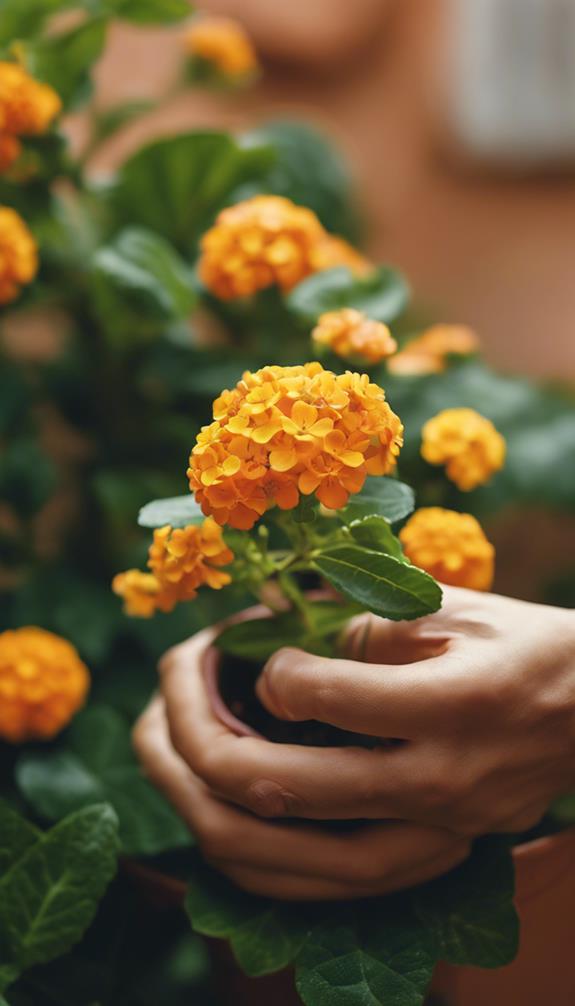
As you've successfully pruned your potted lantana to maintain its shape and size, it's time to focus on encouraging blooms.
Deadheading lantana blooms is a vital step in promoting frequent flowering. Remove spent flowers, or those that have faded or wilted, to encourage the plant to produce more blooms.
This process, called deadheading, triggers the lantana to direct its energy towards producing new flowers instead of seed production. Since lantana has a relatively short lifespan, typically ranging from 3-5 years, maximizing bloom frequency is essential.
Pest and Disease Control

Having invested time and effort into nurturing your lantana plants, you'll want to protect them from pests and diseases that can quickly decimate their health and appearance.
Regularly inspect your plants for signs of pests, such as whiteflies, aphids, and spider mites. Pest identification is key to effective control, so monitor your plants closely and take action immediately if you notice any issues.
For disease prevention, maintain good air circulation and water your plants properly to prevent fungal diseases. Remove any infected leaves or stems to prevent the disease from spreading.
Use organic or chemical controls as needed to eliminate pests and diseases, and consider introducing beneficial insects, like ladybugs, to your pot to promote a balanced ecosystem.
Common Problems to Watch For

Your lantana plants' beauty and health can be compromised by several common issues that require your attention.
One of the most critical problems to watch for is Lantana pests, such as aphids, whiteflies, and spider mites. These pests can weaken your plants and spread diseases. Regularly inspect your plants for signs of infestation, and take prompt action if you notice any issues.
Another common problem is pot boundness, which occurs when the roots outgrow the container. This can cause the plant to become waterlogged, leading to root rot. Make sure to transplant your lantana into a larger pot when necessary, and prune the roots to prevent boundness.
Overwintering Lantana Plants
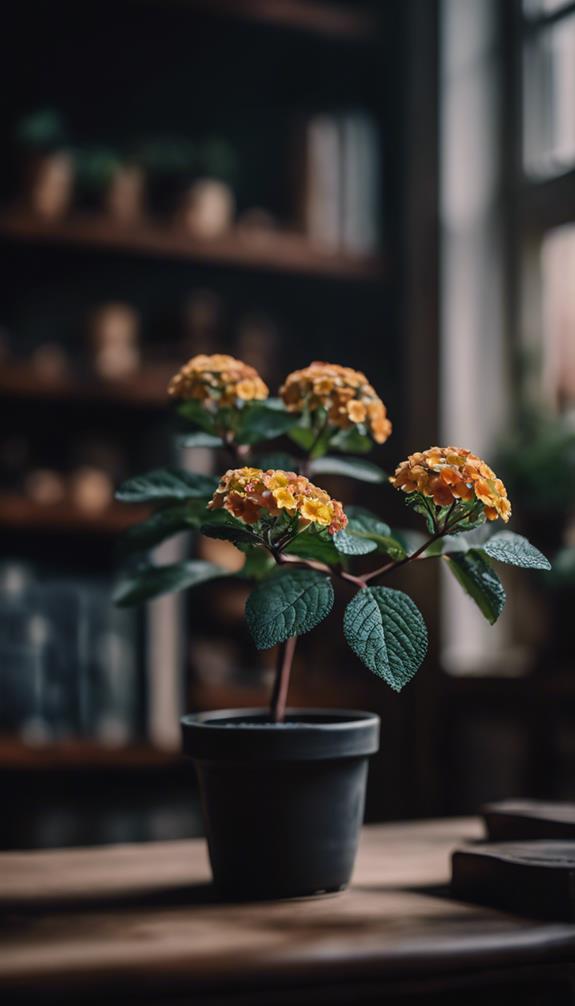
When you live in an area with frost, you'll need to take steps to protect your lantana plants from damage during the winter months.
You'll want to bring your potted lantana plants indoors safely to guarantee they survive until spring, and then you can return them outside.
To do this successfully, you'll need to know how to shield your plants from frost damage and transport them indoors without shocking them.
Protecting From Frost Damage
Lantana plants typically thrive in warm weather, but they're sensitive to frost, which can damage or kill them.
As winter approaches, you'll need to take steps to protect your potted lantana from frost damage. One effective method is to use frost blankets, which can be draped over the pot to insulate the plant.
You can also provide winter protection by wrapping the pot in burlap or a similar material, making sure to cover the entire plant.
Bring the pot to a sheltered location, like a garage or shed, to further shield it from harsh winter conditions.
Bringing Indoors Safely
The onset of winter signals the need to bring your potted lantana plants indoors to safeguard them from harsh outdoor conditions.
Before bringing them inside, inspect your plants for any signs of pests or diseases and treat them accordingly. Prune back the plants to about one-third of their original height to reduce transpiration and promote indoor acclimation.
Move them to a bright, cool location with temperatures between 50°F to 60°F (10°C to 15°C) to guarantee winter protection. Gradually acclimate your lantana plants to indoor conditions over the course of 7-10 days to prevent shock.
Monitor humidity levels and mist the plants as needed to maintain a humid environment. By following these steps, you'll be able to successfully overwinter your potted lantana plants and enjoy their vibrant blooms again come spring.
Propagating Lantana From Cuttings
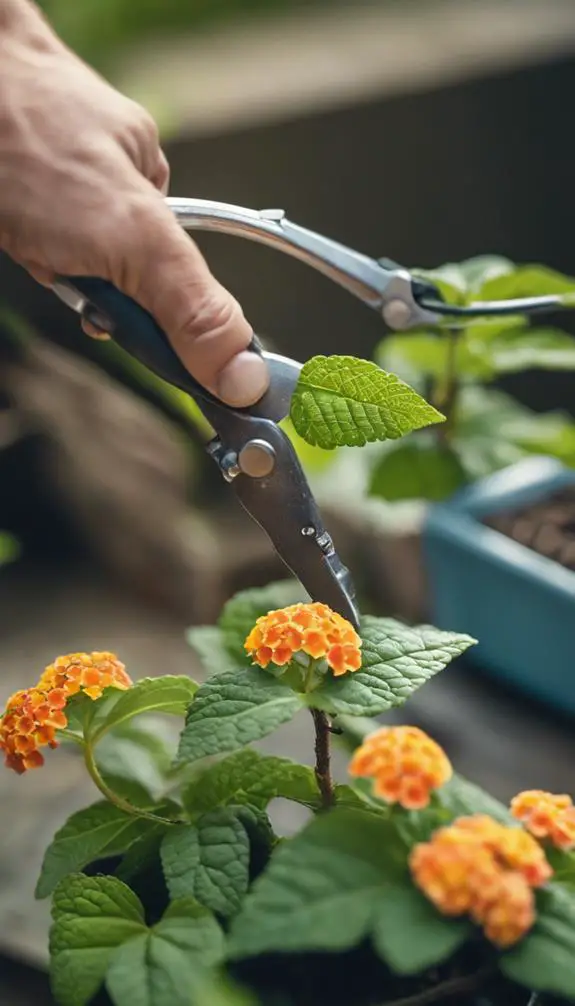
How do you go about propagating lantana from cuttings?
You'll need to take 3- to 5-inch stem cuttings from the tip of a healthy lantana branch. Remove lower leaves, leaving only a few at the top.
Dip the cut end in rooting hormone to increase the chances of successful lantana propagation. Plant the cutting in a pot filled with a well-draining mix, gently firming the soil around it.
Water thoroughly and provide bright, indirect light. Keep the soil consistently moist but not waterlogged. Roots should develop within 2-3 weeks.
Once roots are established, you can transplant the new lantana plant into a larger pot or directly into your garden. Using cutting techniques like these can help you multiply your lantana plants quickly and efficiently.
FAQs
Can Lantana Plants Be Grown Indoors Year-Round?
You can grow lantana plants indoors year-round, but you'll need to provide proper winter care, such as pruning and reducing watering, and guarantee adequate indoor lighting, ideally 4-6 hours of direct sunlight or 12-14 hours of indirect light.
Are Lantana Flowers Safe for Pets to Be Around?
You, as a pet owner, should be aware that lantana flowers contain toxic compounds, posing a moderate risk to your pets; while toxicity levels are relatively low, ingesting even small amounts can cause gastrointestinal issues, so keep them out of reach.
Can I Grow Lantana in a Hanging Basket?
You can create a stunning hanging beauty by growing lantana in a hanging basket, but be prepared for intense Basket care, including frequent watering, fertilizing, and pruning to guarantee the plant thrives in its aerial environment.
Do Lantana Plants Attract Beneficial Pollinators?
You'll delight in knowing that lantana plants are butterfly magnets and bee friends, attracting beneficial pollinators like monarchs, swallowtails, and honeybees with their clusters of small, fragrant flowers, providing a nectar-rich feast that supports local ecosystems.
Can Lantana Be Grown From Seed Instead of Cuttings?
You can grow lantana from seed, but it requires precise soil preparation and ideal seed germination conditions; sow seeds 1/8 inch deep in a well-draining mix, maintaining 75-85°F temperatures and high humidity to encourage successful germination.
Conclusion
You've successfully grown lantana flowers in pots by following the necessary steps. To guarantee continued success, maintain a consistent watering schedule, prune regularly to promote bushy growth, and monitor for pests and diseases. With proper care, your lantana plants will thrive and provide vibrant blooms throughout the growing season. As the season ends, prepare your plants for overwintering to enjoy them again next year.




